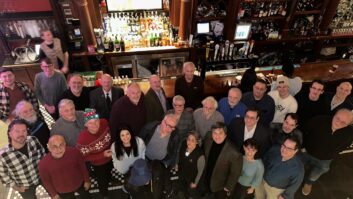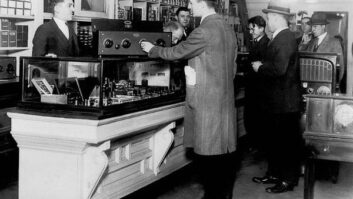New Year’s Eve 2007: Jazz Standard
Feb 1, 2008 12:00 PM

The New York broadcast operation center was this remote truck � a former bread delivery truck.
Our broadcast from the Jazz Standard in New York City went mostly as planned, thanks to great preparation from our broadcast team. A month before the broadcast, I met at the site for a survey with the event and broadcast producers, as well as with Steve Remote of Aurasonic, who provided the mix truck. We spent a few hours talking through how everything would be handled, from power access to running the audio and com (including video) lines from the performance space, through the kitchen and out to the truck.
Unfortunately, I also went back three times after that, to deal with a non-operational ISDN circuit (one of three ordered). Despite several visits from Verizon techs, we were never able to get it functioning, and thus were limited to a 128kb/s primary feed and a 128kb/s backup to NPR in Washington, DC.
Jim Anderson”s music mix was created on a Midas Verona 320 console, using True Systems Precision8 mic pres and a complement of outboard equipment. Recording was to Alesis HD24XR and CD two-track. The mix was fed to the Neustar for N-CLAS preconditioning and A-to-D conversion, then AES into our APT Toyko. A second (backup) feed went directly to a Telos Zephyr Express.
New York Equipment List
- Alesis HD24XR and Tascam CD recorders
- APT Tokyo
- DBX and Kurzweil audio processing
- Harris/Neural Neustar
- Midas Verona 320 mix console
- Neumann, AKG and Shure mics
- Telos Zephyr Express
- True Systems Precision8 microphone pres
David Tallacksen, NPR technical director/NYC venue, Jazz Standard on 27th Street
David Tallacksen is the Operations Director for WBGO, where he is responsible for the technical aspects of their many remote and studio recordings, among other things. He has worked in various technical and production roles in public radio since 2001.
Related ArticlesSan Francisco
You can”t capture everything, but you want to hear almost all the details you can possibly put into it. What you end up doing is filling holes. When something falls out of the mix, you find it and grab it. If something pops up you grab that, too.(more) Dakota Jazz Club
For this presentation by Nachito Herrera, we had three keyboards added at the last minute on a small stage and we were able to work things out. (more) Berklee College of Music
We used two Yamaha DM1000 consoles to do the mix. We also recorded into an Nuendo system (multitrack) for later postproduction. (more) Dazzle Restaurant
Presenting in surround really makes the experience so much better. Jazz typically lends itself to doing surround, because you generally have a real audience and real musicians. It is not heavily post-produced.(more)












